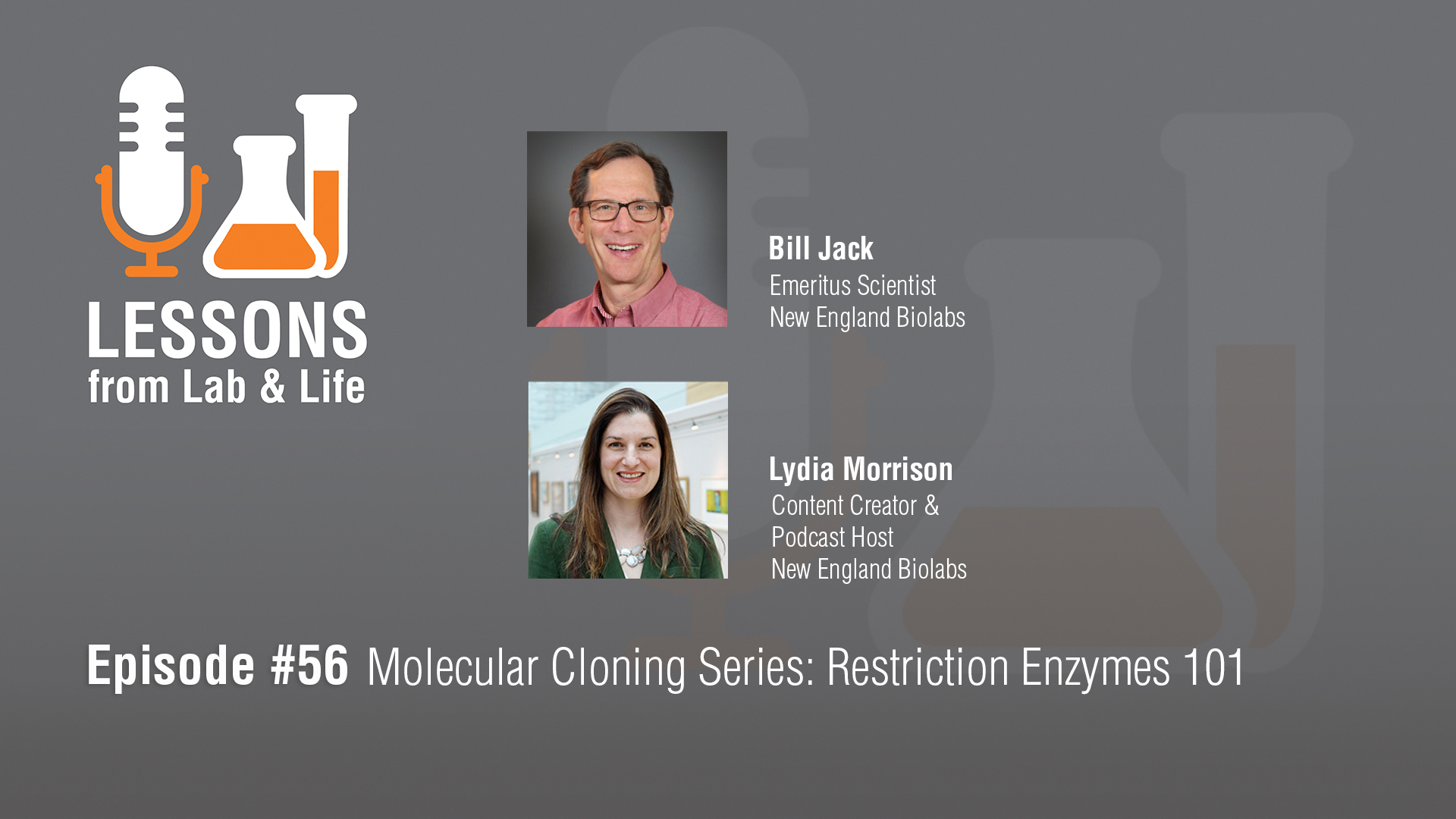
The Vital Role of Restriction Enzymes in Molecular Cloning and DNA Assembly
Posted on Friday, December 8, 2023
By
Topic: Tips for the lab, What is Trending in Science
Molecular cloning is a powerful technique in the field of genetic engineering because it allows scientists to manipulate DNA for various applications. At the heart of this process, restriction enzymes cut DNA at specific sequences and enable mapping, as well as dissection and reassembly of DNA. Restriction enzymes powered the first molecular cloning techniques, and are pivotal in the evolution of more complex DNA assembly methods. New England Biolabs (NEB) Emeritus Scientist Bill Jack helps explain the cutting-edge science, driven by restriction enzymes, behind advanced molecular cloning techniques like Golden Gate Assembly.
Restriction Enzyme Applications in Molecular Biology
Restriction enzymes exist as the foundation of a bacterial immune system. Bacteria fight a constant battle against invasion by bacteriophages, an invasion characterized by injected phage DNA subverting normal cell activities, oftentimes resulting in host cell death. Bill Jack explains, “The restriction enzyme modification immune system functions by cutting incoming foreign DNA into small pieces, using an endonuclease. The cellular exonucleases then chop those fragments up into very, very small pieces, and so the phage infection is aborted.”
The functionality of restriction enzymes extends beyond bacterial defense mechanisms, with pivotal applications in genetic engineering processes.
Today, molecular biologists use various types of restriction enzymes as molecular tools. Type I, II, and III enzymes all share site-specific DNA cleavage activity, but “They can be distinguished based on their different biochemical properties, namely how they recognize the sites that are there, the types of sites that are recognized, and the types of cleavages that occur. The primary type we call Type II, and that's the main tool for molecular biology. And there are some subtypes of restriction enzymes underneath the Type II category.” says Bill Jack.
Understanding their classification is fundamental to appreciating their diverse functions in molecular biology.

Type IIS Restriction Enzymes Mechanism of Action
The mechanism of action of restriction enzymes involves binding and subsequent cleavage of DNA strands. Restriction enzymes recognize specific DNA sequences and cut the DNA at precise locations, generating fragments with either sticky or blunt ends. Type IIS enzymes are distinct in that they cut outside of the recognition sequence. “Many Type IIS enzymes, when they cut, leave a staggered overhang.
In other words, they nick on one strand, and then they nick a certain distance away on the other strand, leaving a single-stranded region. These single-stranded regions have defined nucleotides, which can then be used via complementarity with a similar single-stranded overhang to ligate the pieces together in a defined order. That's probably the use of restriction enzymes that we understand most today.” describes Jack.
Restriction Enzymes in Molecular Cloning
Molecular cloning via the traditional restriction enzyme method is a multi-step process that begins with selection of a vector and insert and a cloning strategy designating which restriction enzymes will be utilized to create the final construct. Following DNA extraction, the vector and insert are both digested with deisgnated restriction enzymes, creating compatible ends for the final ligation step where the DNA pieces are mended together. Today, modern "seamless cloning" techniques, which don't use restriction enzymes, such as NEBuilder HiFi, are also available.
Type IIS Restriction Enzymes in Golden Gate Assembly
Golden Gate Assembly is a molecular cloning technique enabling complex DNA assemblies and offering advantages over traditional cloning methods. Type IIS restriction enzymes are central to performing Golden Gate Assembly. Their unique ability to cleave outside the recognition site overcomes limitations posed by traditional cloning methods and makes possible the efficiency and precision of Golden Gate Assembly. Bill Jack explains, “Since the single-stranded overhang is not defined by the restriction site, it can be essentially any set of nucleotides, and so, there's a great ability to order the type of sequence or the type of overhang that will be there to allow assembly.” By placing the restriction site outside of the fragment of interest, the ability to make a cut and then reassemble without including that recognition sequence allows greater flexibility in assembling constructs.

Advances in Golden Gate Assembly
The development of new restriction enzymes and a better understanding of ligase fidelity have made possible fragment assemblies with >90% accuracy and high efficiency.NEB's Ligase Fidelity Tools aid in the design of high-fidelity Golden Gate Assemblies with the ability to vary experimental conditions. These tools have enabled a variety of advancements in synthetic biology.
NEB offers 50 Type IIS restriction enzymes, several of which are optimized for Golden Gate Assembly, including Esp3I, PaqCI®, BsaI-HF®v2 and BsmBI-v2. To identify which enzymes are the best choice for a specific application, NEB has a sortable Type IIS Restriction Enzyme Table outlining enzyme buffers, reaction temperature, recognition site and more.
Restriction enzymes were involved in the first molecular cloning approaches and continue to play a vital role in advanced DNA assembly techniques such as Golden Gate Assembly. The dynamic nature of molecular biology predicts continuing discoveries and innovations of tools such as restriction enzymes will continue to enable further scientific advances, and the ongoing quest to understand and manipulate DNA.
NEB will not rent, sell or otherwise transfer your data to a third party for monetary consideration. See our Privacy Policy for details. View our Community Guidelines.
Products and content are covered by one or more patents, trademarks and/or copyrights owned or controlled by New England Biolabs, Inc (NEB). The use of trademark symbols does not necessarily indicate that the name is trademarked in the country where it is being read; it indicates where the content was originally developed. See www.neb.com/trademarks. The use of these products may require you to obtain additional third-party intellectual property rights for certain applications. For more information, please email busdev@neb.com.
Don’t miss out on our latest NEBinspired blog releases!
- Sign up to receive our e-newsletter
- Download your favorite feed reader and subscribe to our RSS feed
Be a part of NEBinspired! Submit your idea to have it featured in our blog.


